At we’ve seen in the previous modules, we’re at the start of a dramatic overhaul in how people search for information online. Although relatively new, AI-enhanced search is already the first port-of-call for one in 10 Americans looking for information online, and nearly 80% of are expected to embrace these tools by the end of 2025. This upheaval is increasingly hurting organic traffic numbers and leaving businesses wondering how to avoid getting left behind. The solution is to leverage Generative Engine Optimization (GEO), a new strategy for boosting digital visibility.
Understanding the AI Search Revolution
For decades, traditional search engines served us well by presenting ranked lists of websites gathered by algorithms that evaluated keywords, backlinks, and technical factors. But the new AI-powered search engines, such as ChatGPT, Perplexity, Google Gemini (AI Overviews), and Copilot, operate on much more complex principles (take a look at Module 3 for a complete overview of the main AI search engines). Instead of just finding information and returning a collection of results, these platforms actually synthesize information from multiple sources on demand, creating comprehensive, contextual responses to whatever queries a user gives them.
The Evolution from SEO to GEO
Traditional SEO principles are as important as ever, and both SEO and GEO share the same goals of increasing site visibility, attracting more targeted traffic, and generating conversions and revenue. However, achieving these with AI search means GEO is now an indispensable tool.
While SEO focuses on securing page rankings, GEO is geared toward turning your brand into an authoritative source that AI engines frequently reference when users look for advice. For more information on the differences and similarities between SEO and GEO, go back to Module 2.
Research shows that websites with high domain authority and established expertise are currently more likely to be cited in AI-generated responses. However, this doesn’t mean smaller players can’t compete. The key lies in understanding and implementing effective GEO strategies that focus on quality, authority, and user value.
Key Takeaways:
- GEO aims to establish your brand as an AI-referenced authority
- High domain authority sites are more likely to be cited in AI responses
- Smaller websites can compete through quality content, authority building, and user-focused GEO strategies
Reimagining Keyword Research for the AI Age
GEO keyword research requires recognizing that users don’t always know which solution they need — they only know they have a problem they need to solve. In the past that meant typing words, phrases, or fragmented text into a search engine and digging through the results. Now, users ask AI search tools highly-detailed questions and engage in back-and-forth conversations to get the AI to understand their issue and, hopefully, recommend effective solutions. To contribute to this new ecosystem, we need to move beyond traditional keyword research and develop a fuller picture of the context surrounding user queries.
Consider a business selling project management software. In traditional SEO, you might focus on keywords like “best project management tools” or “project management software pricing.” For GEO, you need to think about the actual problems users are trying to solve: “How can I keep my remote team aligned on project deadlines?” or “What’s the most efficient way to track resource allocation across multiple projects?”
This context optimization approach means your keyword research must consider:
- Question Patterns: How do users naturally phrase their queries when talking to AI?
- User Intent: What problems are users really trying to solve?
- Context Variations: How does the same need manifest in different situations or industries?
Translating these insights into strategy requires a content development approach that lines up with how AI engines process and prioritize information. By organizing your content into carefully structured content collections that address various aspects of user challenges, you can create a rich knowledge base that AI can draw from when generating responses. This not only improves your visibility in AI-generated results but also ensures your solutions are presented in the context most relevant to user needs, increasing the likelihood of meaningful engagement and conversion.
For each content collection, you should identify one primary target keyword and 3-5 supporting long-tail keywords that are at least four words long. These supporting keywords should have lower keyword difficulty and search volume compared to the primary target.
The focus should be on informational and educational intent, as transactional keywords have only a 10% chance of ranking in AI overviews according to a study from Ahrefs. Bottom-of-funnel (BOFU) keywords are the best targets.
For competitor analysis and keyword discovery, you can use a tool like SEMRush to look at keywords ranking for AI overviews. This helps identify what keywords competitors are ranking for that you aren’t, and whether these keywords should be added to your targets.
Key Takeaways:
- GEO requires a shift to understanding conversational queries and user problems
- Context optimization is crucial
- Structure content into organized collections
- Target one primary keyword and 3-5 supporting long-tail keywords
- Prioritize informational/educational content over transactional content
- Bottom-of-funnel keywords are optimal targets
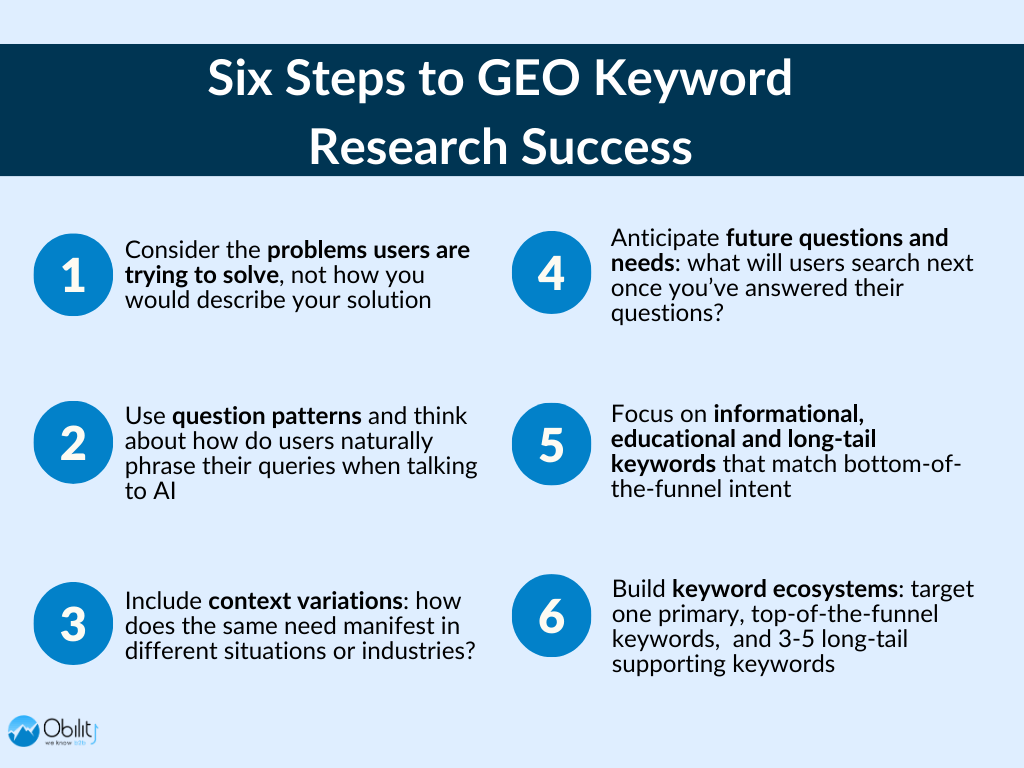
Creating Content That AI Engines Trust
As we’ve seen, success in GEO hinges on developing content that AI engines recognize as authoritative and valuable. This requires going far beyond simple keyword optimization or regurgitating basic information available elsewhere. Instead, focus on developing unique content that is clear, comprehensive, contextually rich, and demonstrates real expertise. Let’s take a look at exactly what that means.
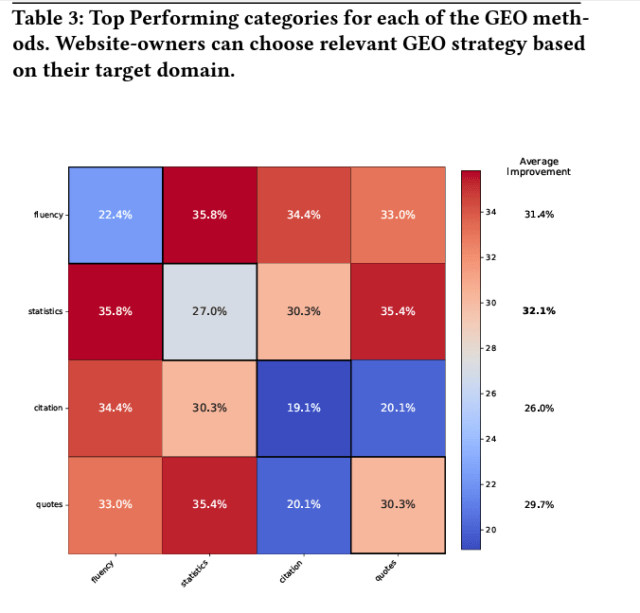
Opening
When writing for GEO, begin each piece with a direct answer to a question or a by providing a concise introduction to the main topic. This helps AI engines quickly grasp the core message and increases the likelihood of your content being featured in their responses. For example, if writing about project management software, start by directly addressing what it is and its primary benefits before diving into details. The introduction should also outline what readers will learn in the sections that follow.
Content Structure
While AI engines are intelligent, they still benefit from clear, logical content structure. This doesn’t mean sacrificing readability to placate machines – quite the opposite. Good structure helps both AI engines and human readers better understand and retain information.
Start with a clear thesis or main point, then build your argument systematically. Use descriptive headings that outline your content’s logical flow, and ensure each section connects naturally to the next. Integrate bullet points and tables to organize information logically – this helps both AI engines and readers digest the main takeaways.
Context Optimization
AI engines prioritize content that thoroughly addresses the full context of a problem, including covering nuances that users might not explicitly mention. Here’s a guide to meeting that high bar:
-
-
Scenario-Based Content Structure
-
Structure content around real-world scenarios to help AI engines connect your posts to various user queries that describe situations rather than solutions. Consider sections like: “For teams struggling with missed deadlines,” or “When remote collaboration causes communication gaps.”
This approach signals to AI engines that your content addresses the contextual reality behind user concerns, making it more likely to be surfaced in responses.
-
-
Semantic Network Building
-
It’s also recommended that you create content that purposefully builds connections between related concepts. AI engines are experts at understanding semantic relationships, so content that thoughtfully links different aspects of a problem space performs better.
For example, when discussing customer relationship management, explicitly connect concepts like “customer retention,” “personalized communication,” and “sales pipeline visibility”—even if they aren’t primary keywords. This helps AI engines recognize your content’s relevance across a spectrum of related queries.
-
-
Anticipatory Content
-
As AI engines tend to discard sources that provide only partial answers, your content should anticipate and answer any likely follow-up questions that may occur to readers, for example in an FAQ format (and don’t forget to add FAQ schema markup!). This preemptive approach also optimizes your content to line up with how users chat with AI search assistants in long back-and-forth conversations.
-
-
Contextual Signals and Markers
-
Use clear contextual signals throughout your content to help AI engines accurately categorize information. This includes:
- Explicit problem statements that match user pain points
- Scenario qualifiers (“for small businesses,” “in regulated industries”)
- Experience-level indicators (“for beginners,” “advanced techniques”)
- Outcome descriptions that align with user goals
These markers help AI engines precisely extract the most relevant portions of your content when synthesizing answers to specific queries.
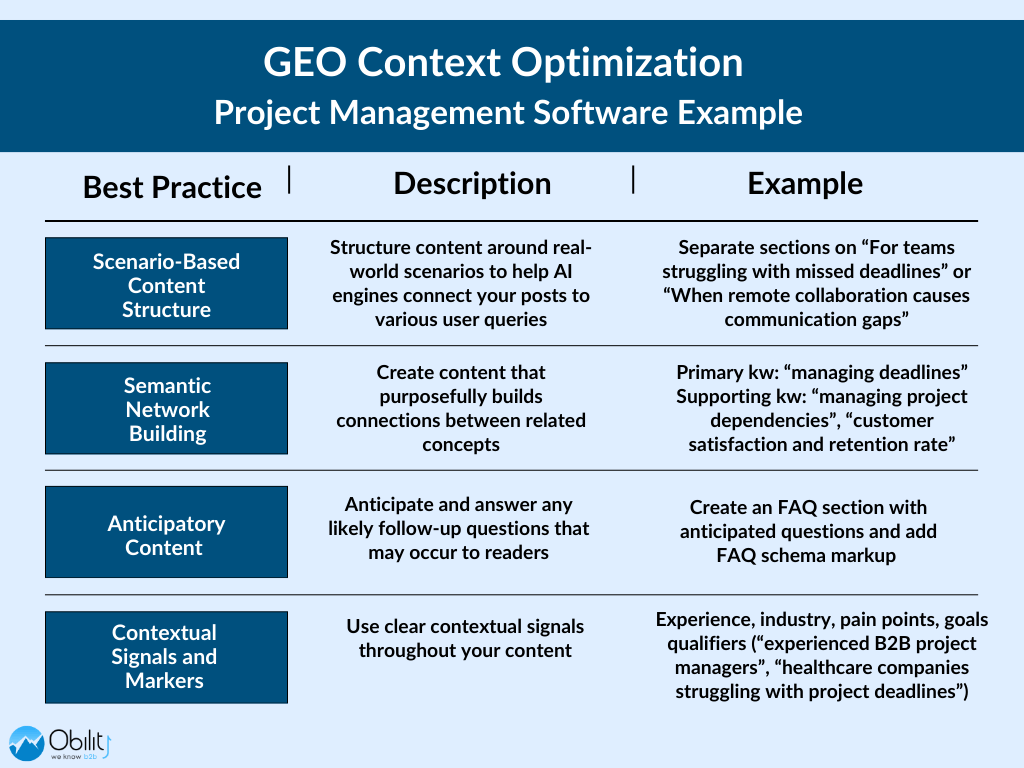
Building Credibility
Create high-quality, authoritative content that follows Google’s E-E-A-T (Experience, Expertise, Authoritativeness, and Trustworthiness) guidelines. Incorporate linked statistics, expert quotations, and citations from high-quality sources throughout your content. Indeed, simply mentioning the origin of a statement can greatly enhance its visibility. When including statistics or quotes, ensure they’re as recent as possible and relevant to maintain freshness and authority. All these elements help AI engines verify the accuracy of information and establish your content’s trustworthiness.
One of the most powerful ways to establish credibility is by providing original research and data. AI engines are particularly likely to reference content that provides unique insights that advance understanding in your field, backed up by solid evidence.
Identify knowledge gaps by looking for questions that existing research hasn’t adequately addressed. What do practitioners in your field struggle to understand? What assumptions need testing? Research becomes more valuable when tracked over time. Consider establishing annual or quarterly studies that monitor trends and changes in your industry.
Language and User Focus
Focus on natural, conversational language that addresses user pain points and questions. Instead of just targeting traditional keywords, think about the kinds of questions users might ask an AI assistant. For instance, rather than optimizing for “best CRM software,” consider phrases like “how can I better manage customer relationships in my small business?” This approach meshes with how users actually interact with AI search engines.
Content Maintenance
Aim to review and refresh your most valuable content pieces every six months, adding new information, updating statistics, and ensuring all citations remain current. This helps maintain your content’s relevance and authority in AI-generated responses.
Quality Balance
Remember, while optimizing for AI engines is your goal, never sacrifice content quality or user value in the process. The best GEO content serves both AI engines and helps human users solve problems or find information efficiently.
Content Collections
Finally, as we mentioned earlier, consider creating content collections that address related topics holistically. This helps establish broader topical authority and increases the likelihood of your content being referenced across multiple AI-generated responses. For example, if you’re writing about digital marketing, create interconnected pieces that cover various aspects like social media, email marketing, and content strategy.
Technical Elements
Traditional technical SEO best practices are still essential. Continue to apply time-tested content, technical, and internal linking SEO recommendations to increase SERP ranking (52% of AI overviews are taken from the top 10 spots). But GEO comes with additional considerations if you want to improve how AI engines interpret and display your content.
For instance, schema markup becomes even more influential in the context of GEO. Properly implemented schema helps AI engines understand not just the content of your pages, but their context and interconnections. This is particularly important for:
- Article structure and relationships
- Product information and specifications
- FAQ content and how-to guides
- Expert and author credentials
It’s also worth noting that Google is no longer the only player that matters, you must make sure your website is also indexed by Bing. ChatGPT has by far the largest share of the AI search market, and it primarily uses Bing as a source. You can use Bing Webmaster Tools to easily import your site from Google Search Console.
Another concern is making certain your content is fully accessible to AI crawlers. This means paying special attention to server-side rendering, following an HTML-first development approach, and avoiding heavy reliance on JavaScript for content delivery.
Additional technical considerations include:
- Page load performance optimization
- Mobile responsiveness and accessibility
- Content delivery network implementation
- Structured data validation and testing
Key Takeaways:
- Use clear, logical structure
- Follow E-E-A-T guidelines
- Discuss real-world scenarios and situations
- Build semantic networks connecting related concepts
- Anticipate and answer likely follow-up questions
- Use contextual signals (problem statements, scenario qualifiers, experience-level indicators)
- Develop original research
- Use natural, conversational language
- Review and refresh valuable content every six months
- Create interconnected content collections
- Implement schema markup
- Ensure your site is indexed by Bing
- Optimize technical elements
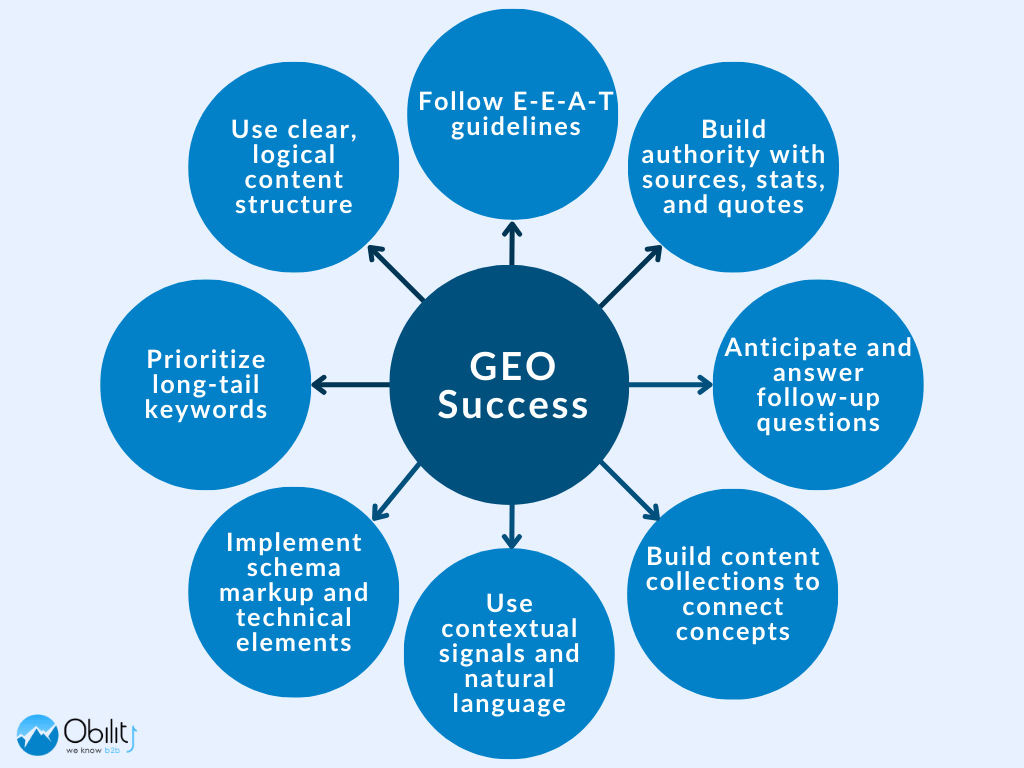
Future-Proofing Your GEO Strategy
With the field of AI search evolving rapidly, what works today may not work tomorrow as AI models evolve, user behaviors shift, and new competitors emerge. Organizations that treat GEO as a one-time implementation rather than an ongoing adaptation process risk finding themselves increasingly invisible in AI-generated responses.
Just as successful businesses continuously adapt their products and services to changing market conditions, your content strategy must become similarly dynamic and responsive. Maintain flexibility in your GEO strategy by:
- Staying informed about developments in AI technology and changes in user behavior.
- Regularly reviewing and updating your content to ensure it remains relevant and authoritative.
- Analyzing AI-generated responses in your field to identify gaps and opportunities.
- Testing different content formats and approaches to optimize AI engine recognition.
Putting It All Together: A Practical Approach
A successful GEO implementation is built on taking a methodical approach. Begin by auditing your existing content and identifying opportunities for optimization. Focus first on your most important topics and gradually expand your efforts across your content library.
Remember that success in GEO isn’t about quick fixes or technical tricks. It’s about consistently creating valuable, authoritative content that genuinely helps users solve their problems. Focus on tapping into sources of real expertise in your field and sharing novel takes and insights in ways that both AI engines and human readers can easily understand and appreciate.
Looking Ahead
As more and more users continue to discover and adopt AI search tools, the advantages of GEO will only multiply. Organizations that upgrade their content strategies now will be better positioned to boost their visibility in this newly established domain. Keep in mind that while the technology may be evolving, one fundamental principle remains unchanged: creating valuable content that genuinely helps your audience enables you to build a strong foundation for long-term success, even in the age of AI search.
To round up your GEO knowledge, head to module 5 to learn about how to measure GEO success.
